Have you ever walked around campus and wondered who made these sculptures? So have we. Almost every day we pass these fascinating, and sometimes bizarre, art pieces, often times not giving them a second thought. Occasionally, though, we’ll look at one and wonder where it came from and who made it. Below we’ve listed three sculptures on campus that have most likely caught your attention at some point, and some of the interesting stories behind them.
Untitled by Peter Vandenberge
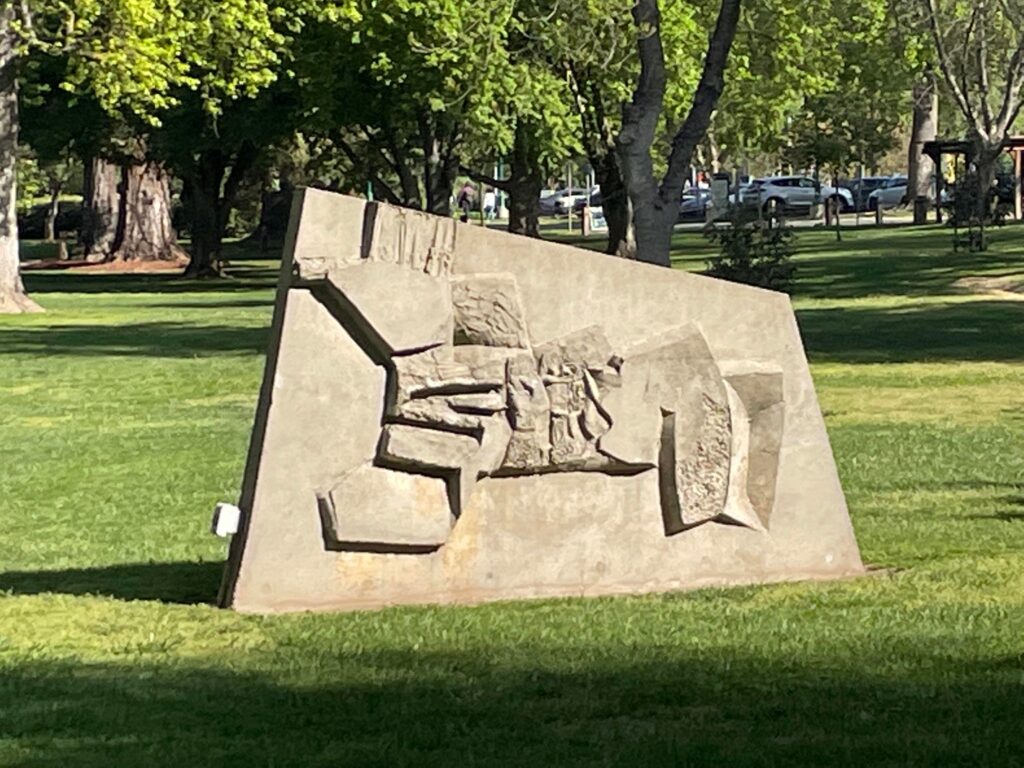
The first sculpture on our list is located outside Douglas Hall and is simply called Untitled. The art piece was made by popular Dutch sculptor Peter Vandenberge in the summer of 1962.1 In addition to being an accomplished artist in the Sacramento area, Vandenberge was also a professor here at Sacramento State from 1973-2003.2
Throughout his career as a sculptor and educator, Peter Vandenberge would become well-known for his unique art style. “Vandenberge is known for larger-than-life elongated busts and figures. The rough surfaces are often carved, dug into, scraped, and painted with underglaze and stains applied with brushes, sponges, and knives.”3
Though this sculpture isn’t a bust like his usual work, it still captures his unique and innovative art style. Typically, a sculpture is cast flat into two pieces which are later brought together and lifted upright.4 This sculpture, however, was cast in one piece, already straight up, directly on the site where it stands today. The cast for this sculpture weighed two and a half tons, making for an incredibly difficult process. Through this project, though, Vandenberge was able to prove the practicality of this casting technique, paving the way toward new, creative uses of cement for artistic purposes.5
One fascinating feature that students may not have noticed are the patterns of the reliefs (sculpted pieces bonded onto a solid background) on each side. These patterns were designed to react to the sunlight during certain times of the day, with the side facing Douglas Hall capturing the effects of the morning sun and the opposite side capturing different effects during the late afternoon.6
The Ternary by Gerald Walburg
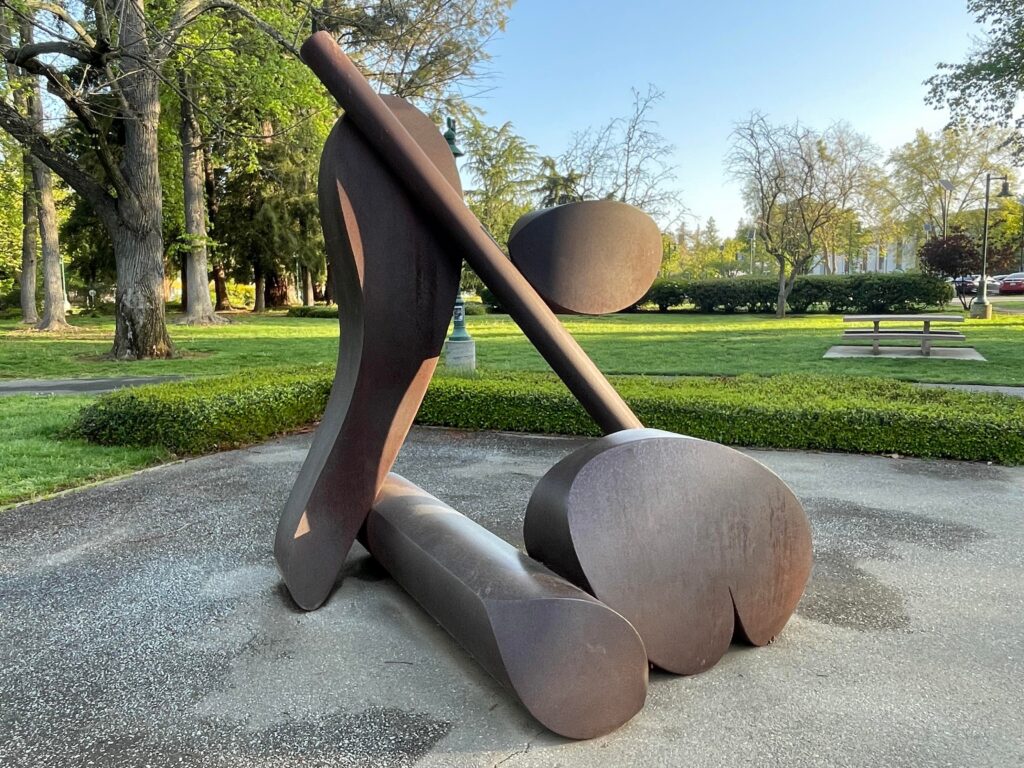
The second sculpture on our list is called The Ternary and was designed by Gerald Walburg in 1988.7 Born in 1936, Walburg would grow up to become a popular postwar and contemporary artist in the Sacramento area.8 Standing at 9ft tall and 7ft wide, The Ternary took Walburg about three months to complete. After being displayed at the Robert Else Gallery for an art show in 1988, the sculpture was placed in the parking lot in between the art sculpture lab and the campus police station along with five other sculptures made by Walburg.9 These sculptures were all closely related to each other, with the same contemporary style and the same rusty-orange metal. When the parking lot was repaved, the sculptures had to be moved. Walburg recommended placing them in sculpture gardens where his work could be interpreted in relation to each other. The art screening committee, which was tasked with moving the sculptures, however, decided to spread them around campus where they can still be found today.10
The Children’s Center Statue by Sally Shapiro
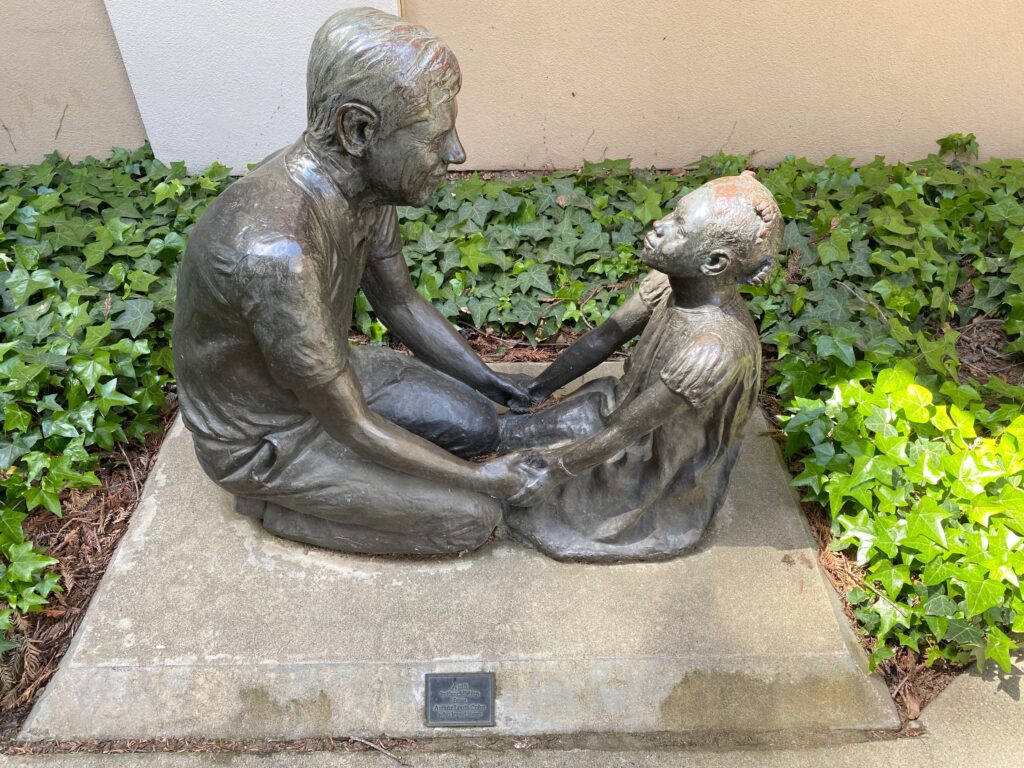
Last on our list is a life-sized bronze statue of an older man playing with a young girl placed right near the entryway to the Children’s Center. This piece was made by Stockton-based artist and Sacramento State art graduate Sally Shapiro as part of a campus-wide art competition in 1988. Inspired by her travels through Central and South America, as well as her time caring for an AIDS patient until his death, Sally adopted the belief that realism and utility could be used as effective tools to create more socially significant art.11 It was this belief that helped her in crafting this statue.
Originally, the art piece was made from clay; however, it was later cast in bronze by the Nordhammer Foundry in Oakland to ensure its longevity. Made as a dedication to Arthur Cohn after his death in 1987, the statue depicts him playing with his goddaughter, Jessica Holloway, who was very dear to him.12 In 1990, the piece was donated to the Children’s Center by Arthur’s wife, Lucille Cohn, who graduated from Sac State in 1956. The statue still sits right outside the entrance to the Children’s Center, where kids climb, play, and even talk to the statue.13
Notes
1“Unique Campus Sculpture was an Experiment in Technique,” The State Hornet, July 14, 1967, https://archive.org/details/css_001711/page/n1/mode/2up?q=sculpture.
2Donald Clark. “Peter Willem VandenBerge, Peter VandenBerge,” The Marks Project, Donald Clark, last modified November 3, 2019, https://www.themarksproject.org/marks/vandenberge.
3Clark, “VandenBerge.”
4“Campus Sculpture,” The State Hornet.
5“Campus Sculpture,” The State Hornet.
6“Campus Sculpture,” The State Hornet.
7David Ryan, “Campus galleries open new exhibits,” The State Hornet, October 11, 1988, https://archive.org/details/css_003176/page/n12/mode/1up?q=gerald+walburg.
8Gerald Walburg. “Chrysanthemum Series,” The Met, accessed April 1, 2023, https://www.metmuseum.org/art/collection/search/482749.
9Holly A. Heyser, “Rusty Metal Sculptures Relocated On Campus,” The State Hornet, October 16, 1984, https://archive.org/details/css_003022/mode/2up?q=walburg.
10Heyser, “Rusty Metal Sculptures.”
11Glenn Matty, “Sculpture Donated To Child Center,” The State Hornet, April 17, 1990, https://archive.org/details/css_003286/page/6/mode/2up?q=sculpture.
12Chelsea J. Carter, “Donated statue has sentimental value,” The State Hornet, September 29, 1992, https://archive.org/details/css_003424/page/n1/mode/2up?q=sculpture.
13Matty, “Sculpture Donated.”
Bibliography
Carter, Chelsea J. “Donated statue has sentimental value.” The State Hornet, September 29, 1992. State Hornet 1992-09-29 : California State University, Sacramento : Free Borrow & Streaming : Internet Archive.
Clark, Donald. “Peter Willem VandenBerge, Peter VandenBerge.” The Marks Project, last modified November 3, 2019. VandenBerge | The Marks Project.
Heyser, Holly A. “Rusty Metal Sculptures Relocated On Campus.” The State Hornet, October 16, 1984. State Hornet 1984-10-16 : California State University, Sacramento : Free Borrow & Streaming : Internet Archive.
Matty, Glenn. “Sculpture Donated To Child Center.” The State Hornet, April 17, 1990. State Hornet 1990-04-17 : California State University, Sacramento : Free Borrow & Streaming : Internet Archive.
Ryan, David. “Campus galleries open new exhibits.” The State Hornet, October 11, 1988. State Hornet 1988-10-11 : California State University, Sacramento : Free Borrow & Streaming : Internet Archive.
“Unique Campus Sculpture was an Experiment in Technique.” The State Hornet, July 14, 1967. State Hornet 1967-07-14 : California State University, Sacramento : Free Borrow & Streaming : Internet Archive.
Walburg, Gerald. “Chrysanthemum Series.” The Met, accessed April 1, 2023. Gerald Walburg | Chrysanthemum Series | The Metropolitan Museum of Art (metmuseum.org).
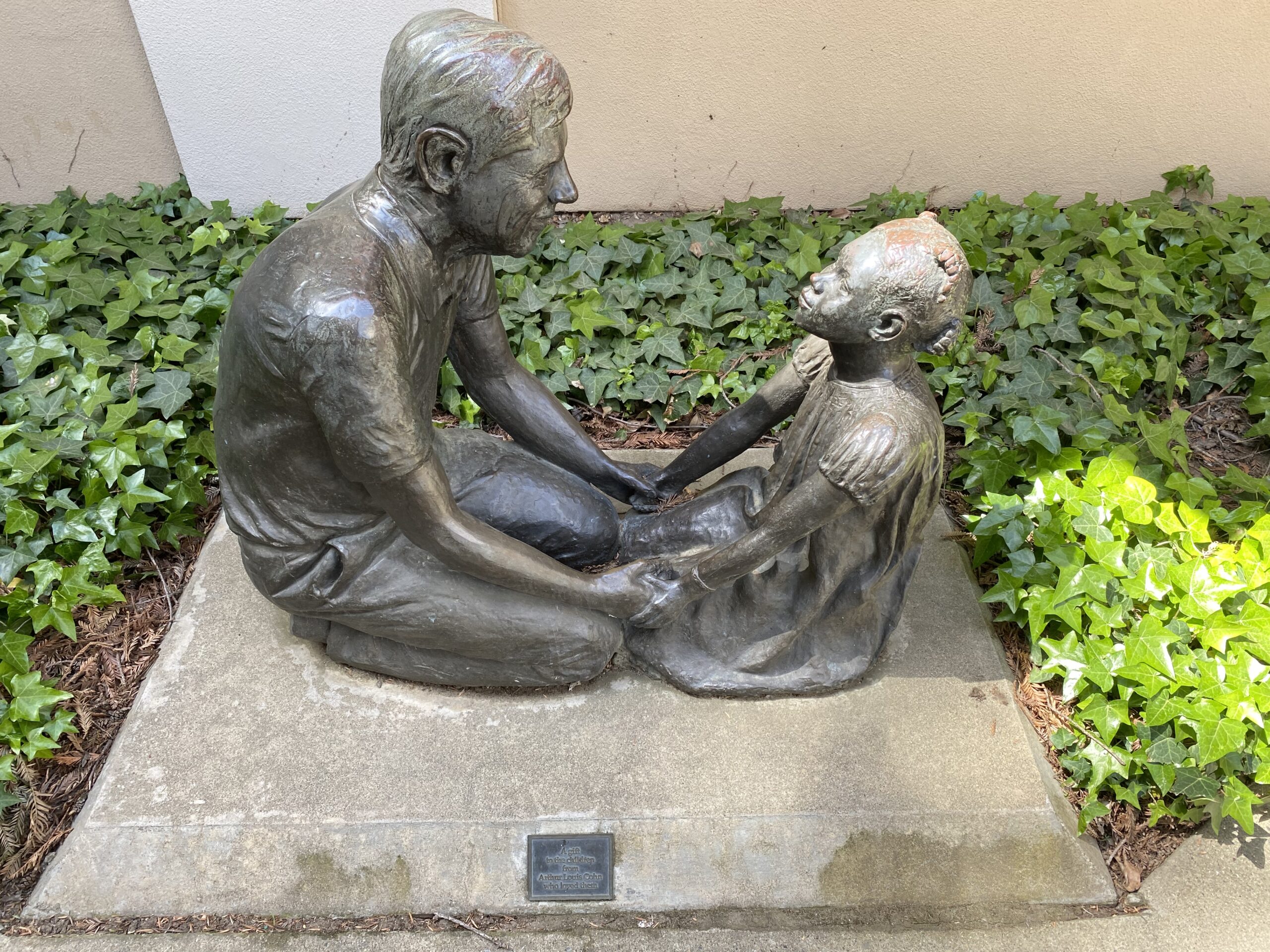
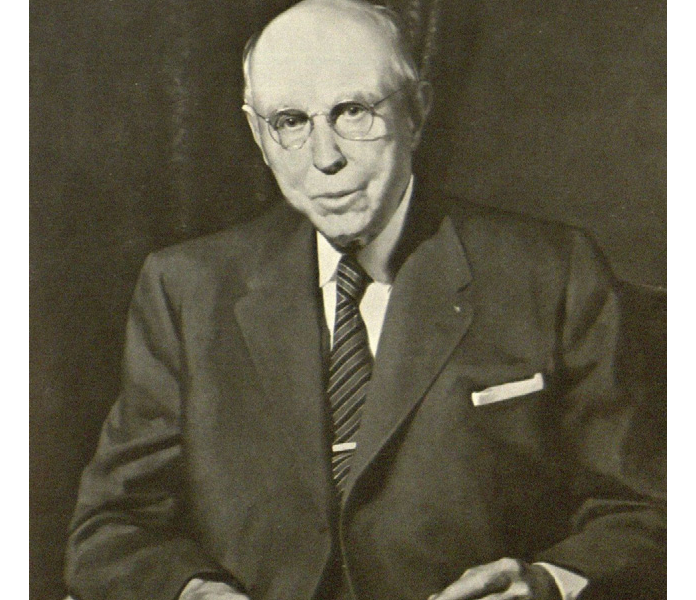

I never knew there was such fascinating history behind some of these statues. I felt the first and third statues were the coolest. The first I did not know to get different effects of the sun for different hours. I am looking forward to trying to notice the differences when I pass by the sculpture. The last one just seemed like an amazing story that had so much Sac State history behind it. It would be hard to not want this statue on campus to be viewed. Perfect placement since it is a grandfather playing with a kid and it is in front of the child center for all to enjoy.
Wow! I find it quite impressive to have learned about what each of these statues represent. In my personal opinion; Both, “Untitled” and “The Ternary” have great stories behind their craft. However, the last statue, “The Children’s Center Statue” by Sally Shapiro brought so much more meaning and awareness as far realism is concerned. As Shapiro explains, art like this can essentially represent social awareness amongst us by connecting with other human beings. Thank you so much for giving us all a clear insight on this pretty interesting topic.